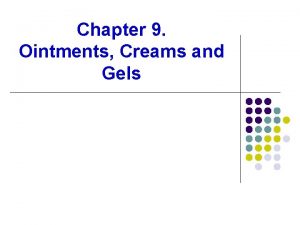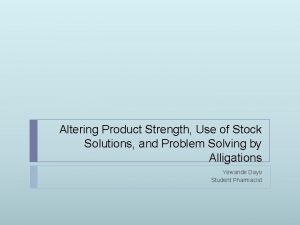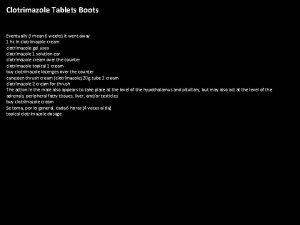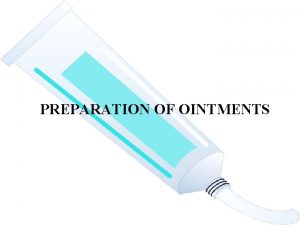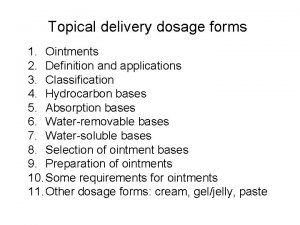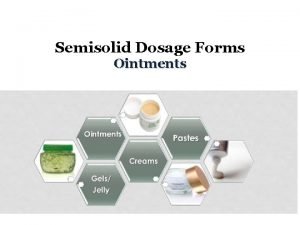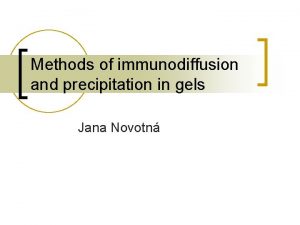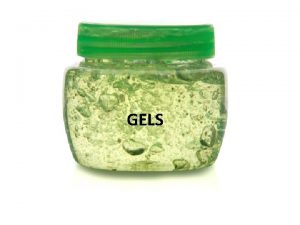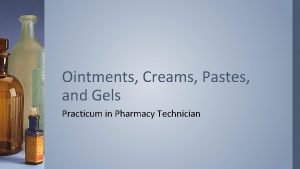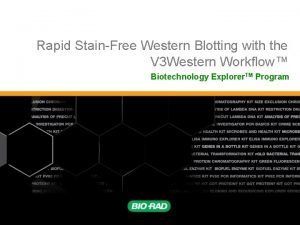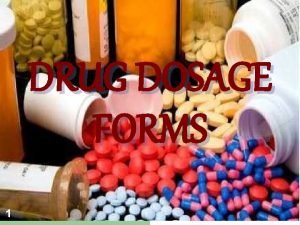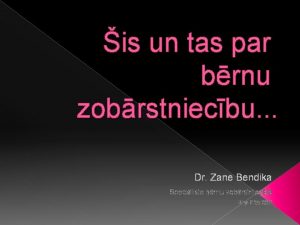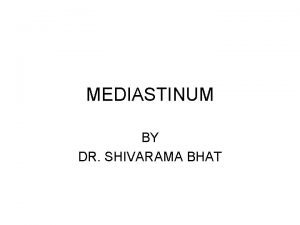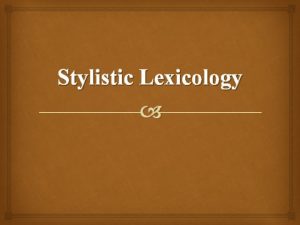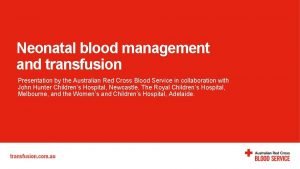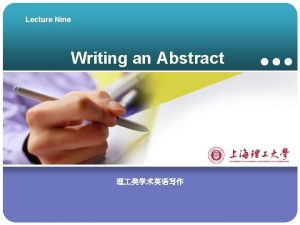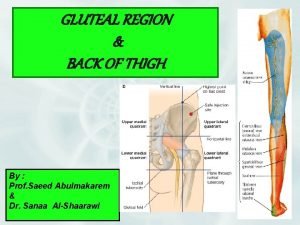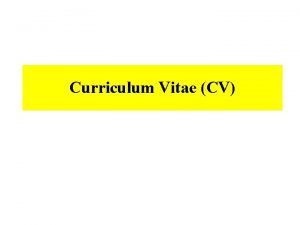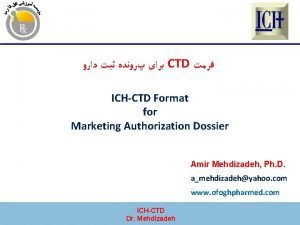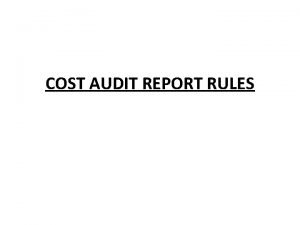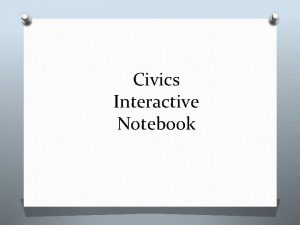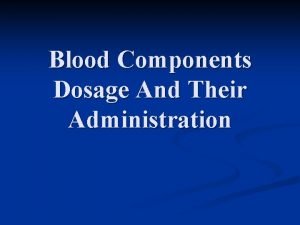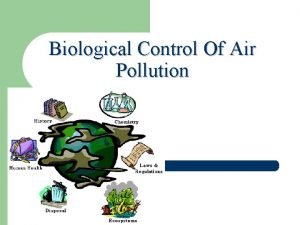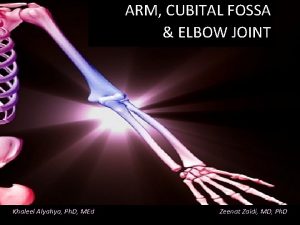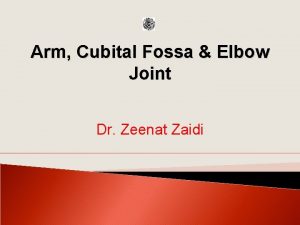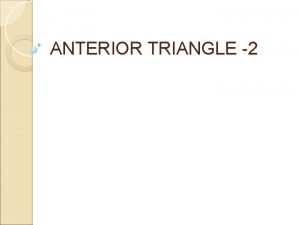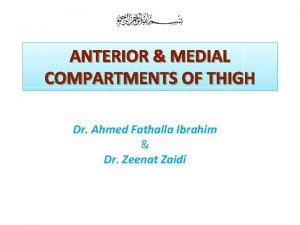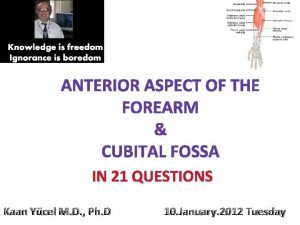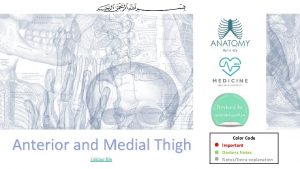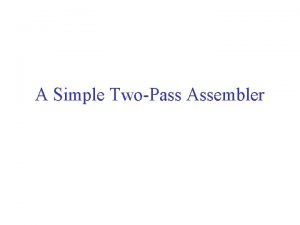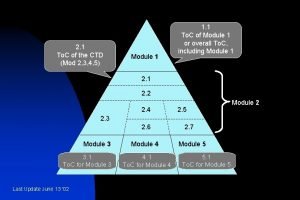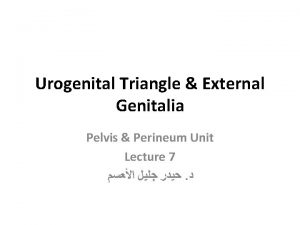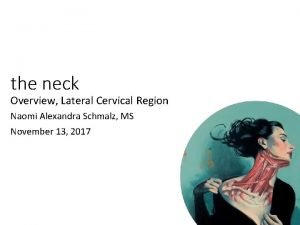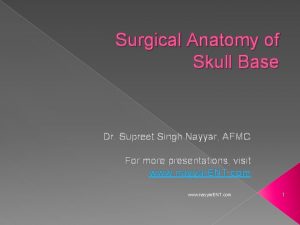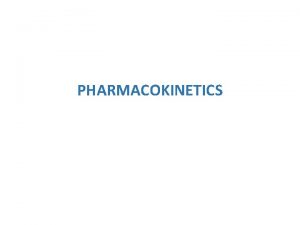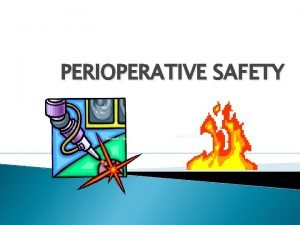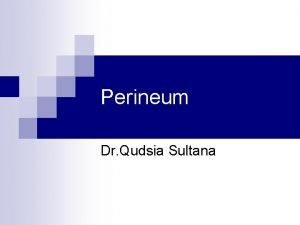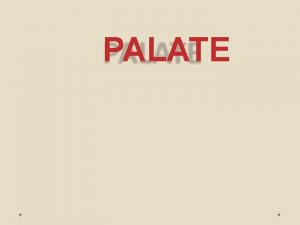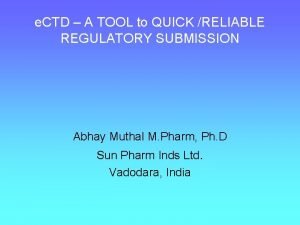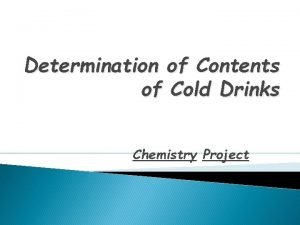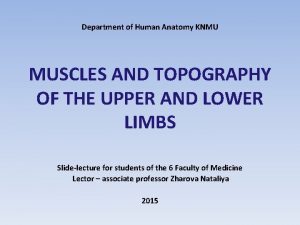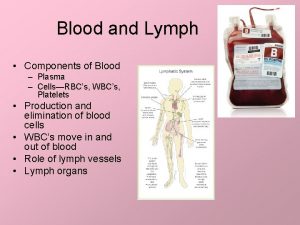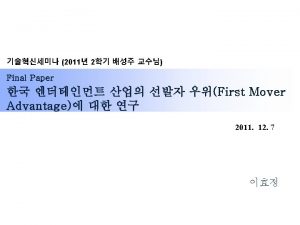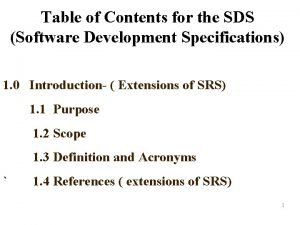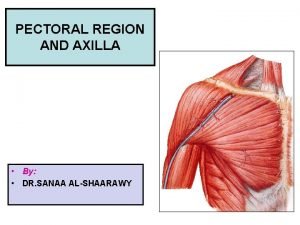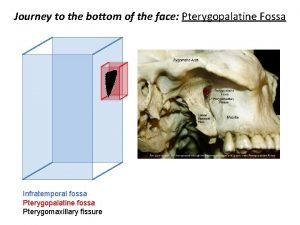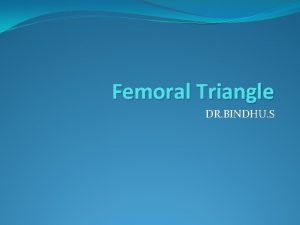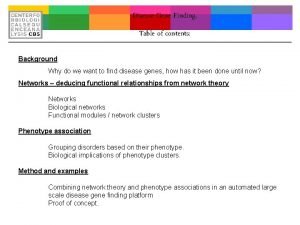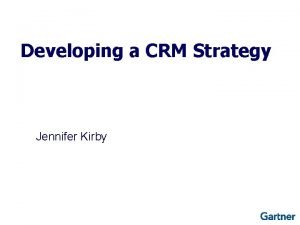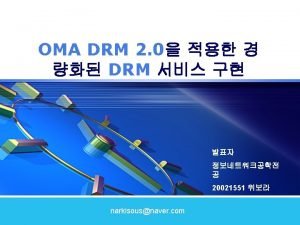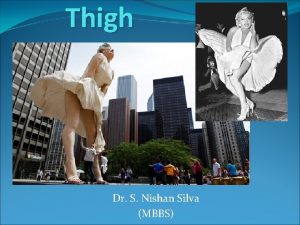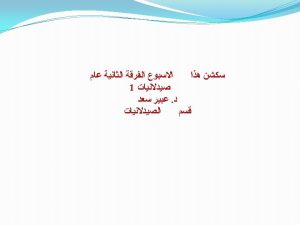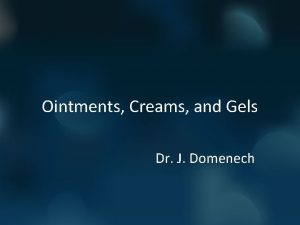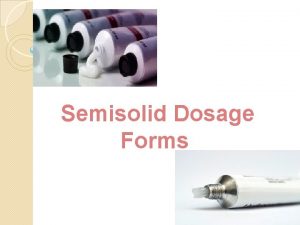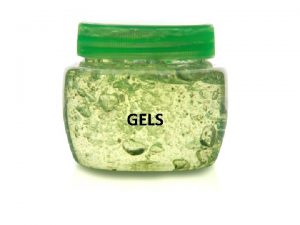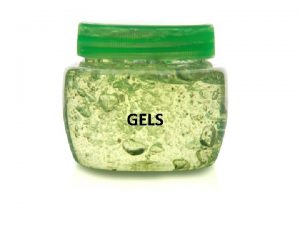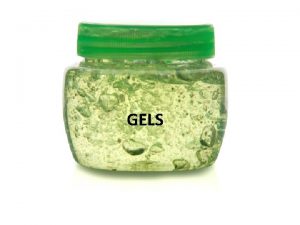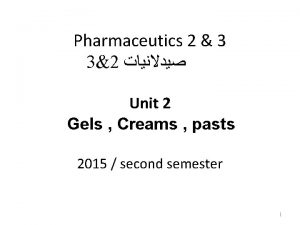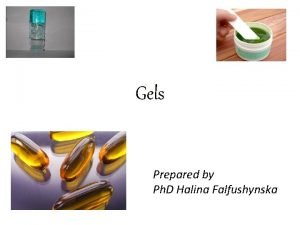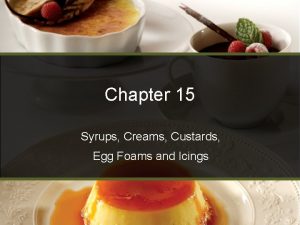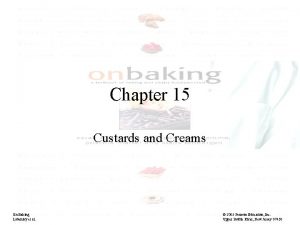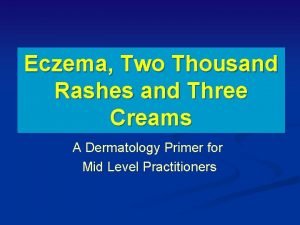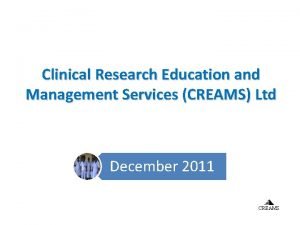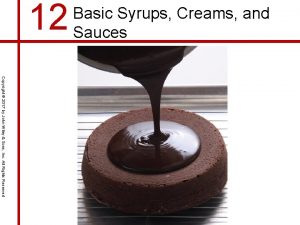Chapter 9 Ointments Creams and Gels Contents I













































































































- Slides: 109

Chapter 9. Ointments, Creams and Gels

Contents I. Ointments II. Compendial requirements for ointments III. Creams IV. Gels V. Miscellaneous semisolid preparations: pastes and plasters

VI. Features and use of dermatologic preparations VII. Features and use of ophthalmic ointments and gels VIII. Features and use of nasal ointments and gels IX. Features and use of rectal preparations X. Features and use of vaginal preparations

l l Ointments, creams and gels are semisolid dosage forms intended for topical application. They may be applied to the skin, placed onto the surface of the eye, or used nasally, vaginally or rectally. Semisolid Dosage Forms 软膏剂 Ointments 霜剂 Creams 凝胶 剂 Gels

l Topical preparations are used for both local and systemic effects. l A topical dermatological product is designed to deliver drug into the skin in treating dermal disorders, with the skin as the target organ.

l A transdermal product is designed to deliver drugs through the skin (percutaneous absorption) to the general circulation for systemic effects, with the skin not being the target organ. l Systemic drug absorption should always be considered when using topical products if the patient is pregnant or nursing.

I. Ointments are semisolid preparations intended for external application to the skin or mucous membranes. F Ointments may be medicated or nonmedicated. F Nonmedicated ointments are used for the physical effects that they provide as protectants, emollients or lubricants.

1. Ointment bases - Ointments bases are classified by the USP into four general groups: hydrocarbon bases absorption bases water-removable bases water-soluble bases

1) Hydrocarbon bases are also termed oleaginous bases. On application to the skin emollient effect occlusive dressings protect against the escape of moisture

Petrolatum (矿脂) ¨ ¨ ¨ is a purified mixture of semisolid hydrocarbons obtained from petroleum. It is an unctuous mass, varying in color from yellowish to light amber(琥珀色). It melts at temperatures between 38 C and 60 C and may be used alone or in combination with other agents as an ointment base. A commercial product is Vaseline.

White Petrolatum is a purified mixture of semisolid hydrocarbons from petroleum that has been wholly or nearly decolorized. It is used for the same purpose as petrolatum. A commercial product is White Vaseline.

Yellow ointment ¨ ¨ is mixture (1000 g) of yellow wax (50 g) and petrolatum (950 g). Yellow wax is the purified wax obtained from the honeycomb of the bee. The ointment is prepared by melting the yellow wax on a water bath, adding the petrolatum until the mixture is uniform, then cooling with stirring until congealed.

White ointment This ointment differs from yellow ointment by substituting white wax and white petrolatum in the formula.

2) Absorption bases are of two types: ¨ Those that permit the incorporation of aqueous solutions resulting in the formation of water-in-oil emulsions (e. g. , hydrophilic petrolatum) ¨ Those that are water-in-oil emulsions and permit the incorporation of additional quantities of aqueous solutions (e. g. , Lanolin)

Absorption bases ¨ ¨ ¨ may be used as emollients; are not easily removed from the skin with water washing since the external phase of the emulsion is oleaginous; are useful as pharmaceutical adjuncts to incorporate small volumes of aqueous solutions into hydrocarbon bases.

Hydrophilic petrolatum, USP has the following formula for the preparation of 1000 g: Cholesterol Stearyl alcohol(硬脂醇) White wax White petrolatum 30 g 80 g 860 g It is prepared by melting the stearyl alcohol and the white wax on a steam bath, adding the cholesterol with stirring until dissolved, adding the white petrolatum and allowing the mixture to cool while being stirred until congealed(凝结).

Lanolin ¨ ¨ obtained from the wool of sheep; is a purified, wax-like substance that has been cleaned, deodorized, and decolorized. It contains not more than 0. 25% water. Additional water may be incorporated into lanolin by mixing.

3) Water-removable bases ¨ ¨ ¨ Water-removable bases are oil-in-water emulsions resembling creams in appearance. Because the external phase of the emulsion is aqueous, they are easily washed from skin and are often called ‘water washable’ bases. They may be diluted with water or aqueous solutions.

Hydrophilic ointment has the following formula for the preparation of about 1000 g: Methylparaben Propylparaben Sodium lauryl sulfate(月桂醇硫酸钠) Propylene glycol(丙二醇) Stearyl alcohol White petrolatum Purified water 0. 25 g 0. 15 g 10 g 120 g 250 g 370 g

In preparating the ointment, the stearyl alcohol and white petrolatum are melted together at about 75 C. The other agents, dissolved in the purified water, are added with stirring until the mixture congeals.

4) Water-soluble bases ¨ ¨ Water-soluble bases do not contain oleaginous components. They are completely water-washable and often referred to as ‘greaseless’(无脂物). Because they soften greatly with the addition of water, large amounts of aqueous solutions are not effectively incorporated into these bases. They mostly are used for the incorporation of solid substances.

Polyethylene glycol ointment ¨ ¨ Polyethylene glycol (PEG) is a polymer of ethylene oxide and water represented by the formula: H(OCH 2)n. OH in which n represents the average number of oxyethylene groups. PEGs having average molecular weights below 600 are clear, colorless liquids; those with molecular weights above 1000 are waxlike white materials; those with molecular weights in between are semisolids.

Selection of the appropriate base ¨ ¨ ¨ Desired release rate of the drug substance from the ointment base; Desirability for topical or percutaneous drug absorption; Desirability of occusion of moisture from the skin;

¨ ¨ ¨ Stability of the drug in the ointment base; Effect of the drug on the consistency or other features of the ointment base The desire for a base that is easily removed by washing with water.

Preparation of ointments Ointments are prepared by two general methods: - Incorporation (加入法) Fusion(融合法) The method used depends primarily on the nature of the ingredients.

Incorporation By the incorporation method, the components are mixed until a uniform preparation is attained. Incorporation of solids: The ointment base is placed on one side of the working surface and the powdered components, previously reduced to fine powders and thoroughly blended in a mortar, on the other side.

¨ A small portion of the powder is mixed with a portion of the base until uniform. ¨ The process is continued until all portions of the powder and base are combined and thoroughly and uniformly blended.

The drug (the pink powder) is usually the smaller quantity of the two ingredients.

Add an amount of the ointment that is approximately equal in size to the drug. Spatulate the mixture.

Add a second portion of the ointment to the spatulated mixture that is about the same size. Spatulate the mixture.

Continue adding until all of the ointment is used. Spatulate after each addition.

l l It often is desirable to reduce the particle size of a powder or crystalline material before incorporation into the ointment base so that the final product will not be gritty. This may be done by levigating or mixing the solid material in a vehicle in which it is insoluble to make a smooth dispersion.

l l l The amount of levigating agent used should be about equal in volume to the solid material. A mortar and pestle is used for levigation. This allows both reduction of particle size and the dispersion of the substance in the vehicle. After levigation, the dispersion is incorporated into the ointment base by spatulation or with the mortar and pestle until the product is uniform.

Incorporation of liquids: ¨ ¨ Liquid substances or solutions of drugs are added to an ointment only after due consideration of an ointment base’s capacity to accept the volume required. When it is necessary to add an aqueous preparation to a hydrophobic base, the solution first may be incorporated into a minimum amount of a hydrophilic base and then that mixture added to the hydrophobic base.

Alcoholic solutions of small volume may be added quite well to oleaginous vehicles or emulsion bases. On a large scale, roller mills force coarsely formed ointments through stainless steel rollers to produce ointments that are uniform in composition and smooth in texture.

Fusion ¨ ¨ By the fusion method, all or some of the components of an ointment are combined by being melted together and cooled with constant stirring until congealed. Medicated ointments and ointment bases containing components as beeswax, paraffin, stearyl alcohol, and high molecular weight polyethylene glycols, which do not lend themselves well to mixture by incorporation, are prepared by fusion.

¨ ¨ On a small scale, the fusion process may be conducted in a porcelain dish(陶瓷盘) or glass beaker. On a large scale, it is carried out in large steam-jacketed kettles(蒸气夹层加热容器). Once congealed, the ointment may be passed through an ointment mill (in largescale manufacture) or rubbed with a spatula or in a mortar (in small-scale preparation) to ensure a uniform texture.











II. Compendial requirements for ointments 1) Microbial content F Ointments must meet acceptable standards for microbial content and preparations which are prone to microbial growth must be preserved with antimicrobial preservatives.

Among the antimicrobial preservatives used to inhibit microbial growth in topical preparations are: F methylparaben, F propylparaben, F phenols, F benzoic acid, F sorbic acid, F quaternary ammonium salts.

2) Minimum fill (最小装量) The USP’s minimum fill test involves the determination of the net weight or volume of the contents of filled containers to assure proper contents compared with the labeled amount.

3) Packaging, storage, and labeling F In large-mouth ointment jars or in metal or plastic tubes; F In well-closed containers to protect against contamination and in a cool place to protect against product separation due to heat;

F In addition to the usual labeling requirements for pharmaceutical products, the USP directs that the labeling for certain ointments and creams include the type of base used (e. g. , water-soluble or water-insoluble).

4) Additional standards In addition to the USP requirements, manufacturers often examine semisolid preparations F for viscosity F for in vitro drug release to ensure intralot and lot-to-lot uniformity.







III. Creams Pharmaceutical creams are semisolid preparations containing one or more medical agents dissolved or dispersed in either an oil-in-water emulsion or in another type of waterwashable base.

¨ ¨ Creams find primary application in topical skin products and in products used rectally and vaginally. Many patients and physicians prefer creams to ointments because they are easier to spread and remove than many ointments.

IV. Gels are semisolid systems consisting of dispersions of small or large molecules in an aqueous liquid vehicle rendered jelly-like through the addition of a gelling agent.

Among the gelling agents used are: ¨ carbomer 934 (卡波姆), ¨ carboxymethylcellulose (羧甲基纤维素 ), ¨ hydroxypropylmethyl-cellulose(羟丙基 甲基纤维素), ¨ Tragacanth(黄芪胶).

Gelling agent Water Preservatives Stabilizers In addition to the gelling agent and water, gels may be formulated to contain a drug substance, co-solvents as alcohol and/or propylene glycol, antimicrobial preservatives as methylparaben and propylparaben or chlorhexidine gluconate(葡萄糖酸洗必泰), and stabilizers as edetate disodium(依地酸 二钠).

熔合法制备凝胶剂 PEG 4000 PEG 400 65℃

Medicated gels may be prepared for administration by various routes including topically to the skin, to the eye, nasally, vaginally, and rectally. ey e skin nasally vaginally, rectally

V. Miscellaneous semisolid preparations 1. Pastes ¨ Pastes are semisolid preparations intended for application to the skin; ¨ They generally contain a larger proportion of solid material than ointments and therefore are stiffer.

¨ Pastes are prepared in the same manner as ointments. ¨ Because of the stiffness of pastes, they remain in place after application and are effectively employed to absorb serous secretions. Because of their stiffness and impenetrability, pastes are not suited for application to hairy parts of the body. ¨

2. Plasters ¨ Plasters are solid or semisolid adhesive masses spread upon a backing material of paper, fabic(布), moleskin(兽皮) or plastic. ¨ Plasters are applied to the skin to provide prolonged contact at the site.

3. glycerogelatins (甘油明胶剂) l Glycerogelatins are plastic masses containing gelatin (15%), glycerin (40%), water (35%), and an added medical substance (10%) as zinc oxide. They are prepared by l First softening the gelatin in the water for about 10 minutes, heating on a steam bath until the gelatin is dissolved,

l l Adding the medicinal substance mixed with the glycerin, Allowing the mixture to cool with stirring until congealed. Glycerogelatin are applied to the skin for long-term residence.

l l Glycerogelatins are melted before application, cooled to slightly above body temperature, and applied to the affected area with a fine brush. Following application, the glycerogelatin hardens, is usually covered with a bandage, and is allowed to remain in place for weeks. The most recent official glycerogelatin was zinc gelatin, used in the treatment of varicose ulcers.

4. packaging semisolid preparation Topical dermatologic products jars or tubes Ophthalmic, nasal, vaginal, and rectal semisolid products tubes

1) Filling ointment jars l Ointment jars are filled on a small scale in the pharmacy by carefully transferring the weighed amount of ointment into the jar with a spatula. l The ointment is packed on the bottom along the sides of the jar, avoiding entrapment of air. l In large-scale manufacture of ointments, pressure fillers force the specified amount of ointment into the jars.

Packing process

Packing process

Packing process

2) Filling ointment tubes l Tubes are filled from the open back end of the tube, opposite from the cap end. l On a small scale, the tube may be filled manually or with a small scale filling manually. l After filling, the tube is closed and sealed.



l Industrially, automatic tube-filling, closing, crimping, and labeling machines are used for the large-scale packaging of semisolid pharmaceuticals. l Depending on the model, machines are available which have the capacity to fill from about 1000 to up to 6000 tubes per hour.

VI. Features and use of dermatologic preparations l l - In treating skin diseases, the drug in a medicated application should penetrate and be retained in the skin for a period of time. Drug penetration into skin depends on a number of factors including the physicochemical properties of the medicinal substance, the characteristics of the pharmaceutical vehicle, the condition of skin itself.

The skin is divided histologically into the - the stratum corneum (the outer layer), - the living epidermis, - the dermis.

l Blood capillaries and nerve fibers rise from the subcutaneous fat tissue into the dermis and subcutaneous layers rise to the skin’s surface. l Sebaceous glands, sweat glands, and hair follicles originating in the dermis and subcutaneous layers rise to the skin’s surface.


l Hair follicles and gland ducts can provide entry for drug molecules, but because their relative surface area is so minute compared to the total epidermis they are minor factors in drug absorption. l The stratum corneum, being keratinized tissue, behaves as a semipermeable artificial membrane, and drug molecules can penetrate by passive diffusion.

- The rate of drug movement across the skin layer depends on the drug concentration in the vehicle, its aqueous solubility, the oil/water partition coefficient between the stratum corneum and the product’s vehicle. Substances that possess both aqueous and lipid solubility charateristics are good candidates for diffusion through the stratum corneum.

l For topical products, treatment is based on qualitative measures with clinical efficacy often varying between patients and products. l Differences in emollient and occlusive effects and ease of application and removal between products is a factor of the base used and product type.

l l Oleaginous bases provide greater occlusion and emollient effects than do hydrophilic or water-washable bases. Pastes offer even greater occlusion and are more effective than ointments at absorbing serous discharge. Creams, usually oil-in-water emulsions, spread more easily than ointments and are easier for the patient to remove. Water-soluble bases are nongreasy and are applied and removed easily.

- The pharmacist should be certain that the patient understands the proper method of administration, frequency and duration of use, special warnings, therapeutic goals, signs of adverse response, allergic sensitivity, etc.

VII. Features and use of ophthalmic ointments and gels The major route by which drugs enter the eye is by simple diffusion via the cornea, the conjunctive and sclera provide an alternate route.

- The cornea is a trilaminate structure with a lipophilic epithelial layer, a hydrophilic stromal layer, an less lipophilic endothelial layer on the inside. Lipophilic drugs are more capable of penetration than hydrophilic compounds.

- - - Ocular drug penetration is limited due to the short residence time that ophthalmic preparations have on the surface of the eye because of their rapid removal by tearing and other natural mechanisms, the small surface area of the cornea for drug absorption, the cornea’s natural resistance to drug penetration.

The ointment base selected for an ophthalmic ointment - - must be non-irritating to the eye, must permit the diffusion of the medicinal substance throughout the secretions bathing the eye, should have a softening point close to body temperature.

The bases in ophthalmic ointments are - - mixtures of white petrolatum and liquid petrolatum, lanolin, polyethylene glycol, mineral oil.

In addition to the quality standards for ointments, ophthalmic ointments also must meet - the USP Sterility Tests the test Metal Particles

VIII. Features and use of nasal ointments and gels l l l The nose is a respiratory organ which is a passage-way for air to the lungs. Its surface is coated with a continuous thin layer of mucous. The mucous contains lysozyme, glycoproteins and immunoglobulins.

l Drugs introduced into the nasal passage are primarily for localized effects on the mucous membranes and underlying tissues. l Drug absorption to the general circulation does occur through the rich blood supply feeding the nasal lining.

- The nasal route of administration is used for the systemic absorption of a number of drugs including butorphanol tartrate(酒石酸布托啡诺) analgesic cyanocobalamin(维生素B 12) hematopoietic (造血剂) narfaralin acetates, endometriosis (子 宫内膜异位) nicotine

The nasal route holds great promise for the administration of insulin, vaccines and a number of other polypeptides and proteins.

IX. Features and use of rectal preparations Ointments and creams are used for topical application to the perianal area and for insertion within the anal canal. l They largely are used to treat local conditions of - anorectal pruritus (瘙痒症) - inflammation - the pain and discomfort associated with hemorrhoids (痔疮). l

The drugs employed include - astringents 收敛剂 (e. g. , zinc oxide) - protectants and lubricants (e. g. , cocoa butter, lanolin) - local anesthetics (e. g. , pramoxine HCl,盐 酸普莫卡因), - Antipruritics (抗瘙痒) - anti-inflammatory agents (e. g. , hydrocortisone)

l Substances applied rectally may be absorbed by diffusion into the general circulation via the network of three hemorrhoidal arteries and accompanying veins in the anal canal. l The rectal route is used for the systemic absorption of therapeutic levels of certain drugs (e. g. , prochlorperazine 氯吡嗪) when oral route is unsatisfactory, as in conditions of vomiting.

- - - The bases used in anorectal ointments and creams include combinations of polyethylene glycol 300 and 3350, emulsion cream bases utilizing cetyl alcohol (十六醇)and cetyl esters (十六 酯) wax, white petrolatum, mineral oil.

X. Features and use of vaginal preparations l The vaginal surface is lined with squamous(皱 纹状)epithelium cells and mucous produced from various underlying glands. l Topical products are used to treat Vulvovaginal (外阴) infections Vaginitis (阴道炎) conditions of endometrial atrophy (子宫内膜萎 缩症) for contraception with spermatocidal agents -

Among the anti-infective agents used in the various anti-infective products are - Nystatin (制霉菌素) Clotrimazole (克霉唑) Miconazole (咪康唑) Clindamycin (氯洁霉素) Sulfonamides (磺胺类药物)

l Endometrial atrophy may be treated locally with the hormonal substances dienestrol(双烯雌酚) and progesterone (黄体酮) which are used to restore the vaginal mucosa to its normal state. l Contraceptive preparations containing spermicidal agents as nonoxynol-9 (壬苯 醇醚)and octoxynol (辛苯聚糖)are used alone or in combination with a cervical diaphragm(避孕环)。

Ointments, creams, and gels for vaginal use are packaged in tubes, vaginal foams in aerosol canisters.

Questions 1.Explain shortly: ointments, creams, gels, pastes, plasters 2.How many different types of ointment bases? What are they? Explain shortly. 3.How to prepare the ointments? 4.What are the characteristics of creams, gels, pastes and plasters? 5. What are the features and use of dermatologic, ophthalmic, nasal, rectal and vaginal preparations respectively?
 Preparation of ointments pastes creams and gels
Preparation of ointments pastes creams and gels Alligation calculator creams and ointments
Alligation calculator creams and ointments Alligation medial
Alligation medial Alligation method
Alligation method Clotrimazole cream boots
Clotrimazole cream boots Preparation of ointment by fusion method
Preparation of ointment by fusion method Topical dosage and delivery
Topical dosage and delivery Anhydrous absorption base
Anhydrous absorption base Semi solids dosage forms
Semi solids dosage forms Describe how light cured gels are applied over forms.
Describe how light cured gels are applied over forms. Precipitation antibody
Precipitation antibody Gels are
Gels are Pastes pharmacy
Pastes pharmacy Stain free gels
Stain free gels What is dosage form
What is dosage form Pempfigus
Pempfigus Contents of the dead man's pocket
Contents of the dead man's pocket Visceral layer of serous pericardium
Visceral layer of serous pericardium Outlining and organizing the speech contents
Outlining and organizing the speech contents Elagse
Elagse Define career portfolio
Define career portfolio Deep perineal pouch contents
Deep perineal pouch contents Trali symptoms
Trali symptoms Ffp
Ffp Mediastinum
Mediastinum Scarpa triangle
Scarpa triangle Level of the sternal angle
Level of the sternal angle The immortal life of henrietta lacks table of contents
The immortal life of henrietta lacks table of contents Medial lemniscus
Medial lemniscus Intermuscular spaces of scapular region
Intermuscular spaces of scapular region Ark of the covenant lampstand
Ark of the covenant lampstand Anatomy of a comic
Anatomy of a comic Laparoyomy
Laparoyomy Mla table of contents
Mla table of contents Contents of stylistic lexis
Contents of stylistic lexis How to make school magazine cover page
How to make school magazine cover page Examples of continuous variables
Examples of continuous variables Appendices example in report
Appendices example in report Platelets transfusion indication
Platelets transfusion indication Anterior mediastinum contents
Anterior mediastinum contents Mediastinum and pericardium
Mediastinum and pericardium Abstract contents
Abstract contents Persepolis table of contents with page numbers
Persepolis table of contents with page numbers Persepolis table of contents
Persepolis table of contents Interactive notebook table of contents
Interactive notebook table of contents Cryopercipitate
Cryopercipitate Pedunculus cerebri
Pedunculus cerebri Coverings of spermatic cord
Coverings of spermatic cord Greater trochanter insertion
Greater trochanter insertion Event planning swot analysis of event organizer
Event planning swot analysis of event organizer Anterior mediastinum contents
Anterior mediastinum contents Mediastinum image
Mediastinum image Contents of carotid sheath
Contents of carotid sheath Triangular space contents
Triangular space contents Contents of curriculum vitae
Contents of curriculum vitae Ctd module 3
Ctd module 3 Give a specimen of cost audit report
Give a specimen of cost audit report Civics interactive notebook
Civics interactive notebook The city of ember summary
The city of ember summary Fresh frozen plasma contents
Fresh frozen plasma contents Contents of air pollution
Contents of air pollution Magazine contents page analysis
Magazine contents page analysis Nerve in cubital fossa
Nerve in cubital fossa Fossa in elbow joint
Fossa in elbow joint Triangle
Triangle Thigh muscles medial
Thigh muscles medial Cubital fossa contents
Cubital fossa contents Quad origin
Quad origin Glenohumeral ligament attachment
Glenohumeral ligament attachment Historical significance of hamlet
Historical significance of hamlet Mnemonic operation code
Mnemonic operation code Ctd modules
Ctd modules Deep perineal pouch
Deep perineal pouch Importance of edp
Importance of edp Table of contents scrapbook
Table of contents scrapbook Ramus angle
Ramus angle Table of contents science
Table of contents science Styloid apparatus
Styloid apparatus Science project setup
Science project setup Difference between absolute and relative bioavailability
Difference between absolute and relative bioavailability Bovie pad
Bovie pad Structures piercing perineal membrane
Structures piercing perineal membrane Roof of the oral cavity
Roof of the oral cavity Trial master file contents
Trial master file contents Purpose of health education
Purpose of health education Module 3 ctd table contents
Module 3 ctd table contents Acknowledgement of chemistry project
Acknowledgement of chemistry project Iliopectineal groove
Iliopectineal groove Contents of a dead man's pocket conflict
Contents of a dead man's pocket conflict Plasma components
Plasma components Table of contents interactive notebook
Table of contents interactive notebook Table of contents science
Table of contents science Table of contents sample
Table of contents sample Table of contents literature review
Table of contents literature review Sds table of contents
Sds table of contents Epq physics ideas
Epq physics ideas Logbook science fair
Logbook science fair Scientific logbook example
Scientific logbook example Serratus anterior origin and insertion
Serratus anterior origin and insertion Infratemporal fossa
Infratemporal fossa Branches of femoral artery
Branches of femoral artery Table of contents background
Table of contents background Crm vision examples
Crm vision examples Profile contents
Profile contents Company profile table of content
Company profile table of content Clovis unified school district preschool
Clovis unified school district preschool Memorandum
Memorandum Contents provider
Contents provider Full use case description
Full use case description Femoral triangle boundaries
Femoral triangle boundaries
